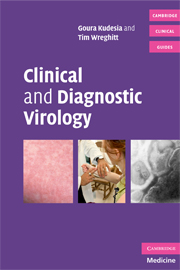Book contents
- Frontmatter
- Contents
- List of plates
- Preface
- Acknowledgements
- SECTION 1 INDIVIDUAL VIRUSES
- Introduction to virology
- 1 Adenoviruses
- 2 Arboviruses and haemorrhagic fever viruses
- 3 Cytomegalovirus (CMV)
- 4 Epstein–Barr virus (EBV)
- 5 Enteroviruses
- 6 Hepatitis A virus (HAV)
- 7 Hepatitis B and D viruses (HBV and HDV)
- 8 Hepatitis C virus (HCV)
- 9 Hepatitis E virus (HEV)
- 10 Herpes simplex virus (HSV)
- 11 Human immunodeficiency virus (HIV) and acquired immunodeficiency syndrome (AIDS)
- 12 Human herpes viruses types 6, 7 and 8 (HHV 6, 7 and 8)
- 13 Human T-cell leukaemia virus (HTLV)
- 14 Influenza viruses
- 15 Measles virus
- 16 Mumps virus
- 17 Noroviruses
- 18 Parainfluenza viruses
- 19 Papilloma and polyoma viruses
- 20 Parvovirus B19
- 21 Pox viruses
- 22 Rabies virus
- 23 Respiratory syncytial virus (RSV)
- 24 Rhinoviruses
- 25 Rotavirus
- 26 Rubella virus
- 27 SARS CoV and other coronaviruses
- 28 Varicella-zoster virus (VZV)
- SECTION 2 OTHER RELATED AGENTS
- SECTION 3 CLINICAL SYNDROMES
- SECTION 4 DIAGNOSTIC TECHNIQUES
- SECTION 5 PATIENT MANAGEMENT
- Index
- Plate section
2 - Arboviruses and haemorrhagic fever viruses
Published online by Cambridge University Press: 07 December 2009
- Frontmatter
- Contents
- List of plates
- Preface
- Acknowledgements
- SECTION 1 INDIVIDUAL VIRUSES
- Introduction to virology
- 1 Adenoviruses
- 2 Arboviruses and haemorrhagic fever viruses
- 3 Cytomegalovirus (CMV)
- 4 Epstein–Barr virus (EBV)
- 5 Enteroviruses
- 6 Hepatitis A virus (HAV)
- 7 Hepatitis B and D viruses (HBV and HDV)
- 8 Hepatitis C virus (HCV)
- 9 Hepatitis E virus (HEV)
- 10 Herpes simplex virus (HSV)
- 11 Human immunodeficiency virus (HIV) and acquired immunodeficiency syndrome (AIDS)
- 12 Human herpes viruses types 6, 7 and 8 (HHV 6, 7 and 8)
- 13 Human T-cell leukaemia virus (HTLV)
- 14 Influenza viruses
- 15 Measles virus
- 16 Mumps virus
- 17 Noroviruses
- 18 Parainfluenza viruses
- 19 Papilloma and polyoma viruses
- 20 Parvovirus B19
- 21 Pox viruses
- 22 Rabies virus
- 23 Respiratory syncytial virus (RSV)
- 24 Rhinoviruses
- 25 Rotavirus
- 26 Rubella virus
- 27 SARS CoV and other coronaviruses
- 28 Varicella-zoster virus (VZV)
- SECTION 2 OTHER RELATED AGENTS
- SECTION 3 CLINICAL SYNDROMES
- SECTION 4 DIAGNOSTIC TECHNIQUES
- SECTION 5 PATIENT MANAGEMENT
- Index
- Plate section
Summary
Haemorrhagic fever viruses
Haemorrhagic fever viruses are viruses that cause outbreaks of severe or fatal infections with haemorrhagic symptoms, principally in the tropics. These infections are occasionally imported into the UK and other countries outside the tropics, usually causing disease in individual persons, but occasionally resulting in clusters of cases of those infections with person-to-person spread. Since there are several different viruses with different geographical distributions, animal vectors and symptoms, these details have been collated inTable 2.1 to aid differential diagnosis. Knowledge of the outbreaks occurring in different parts of the world and the recent travel history of returning travellers is very important for initial clinical diagnosis. Malaria should always be considered in the differential diagnosis. If haemorrhagic fever is suspected patients should be initially cared for in the highest security isolation rooms available, and immediately transferred to a specialist facility designed to care for cases with haemorrhagic fever once malaria is excluded. No special infection control precautions are required for hantavirus and dengue virus infections.
Although dengue fever is the most common of these viral infections to be imported into the UK, the haemorrhagic form of the disease is relatively rare.
Specimens for diagnosis
EDTA blood for virus culture, or polymerase chain reaction (PCR) and clotted blood for specific IgM antibody. In the UK all diagnostic tests are carried out, according to the Advisory Group on Dangerous Pathogens (ACDP) guidelines, in a category 4, high-security facility.
- Type
- Chapter
- Information
- Clinical and Diagnostic Virology , pp. 10 - 16Publisher: Cambridge University PressPrint publication year: 2009



